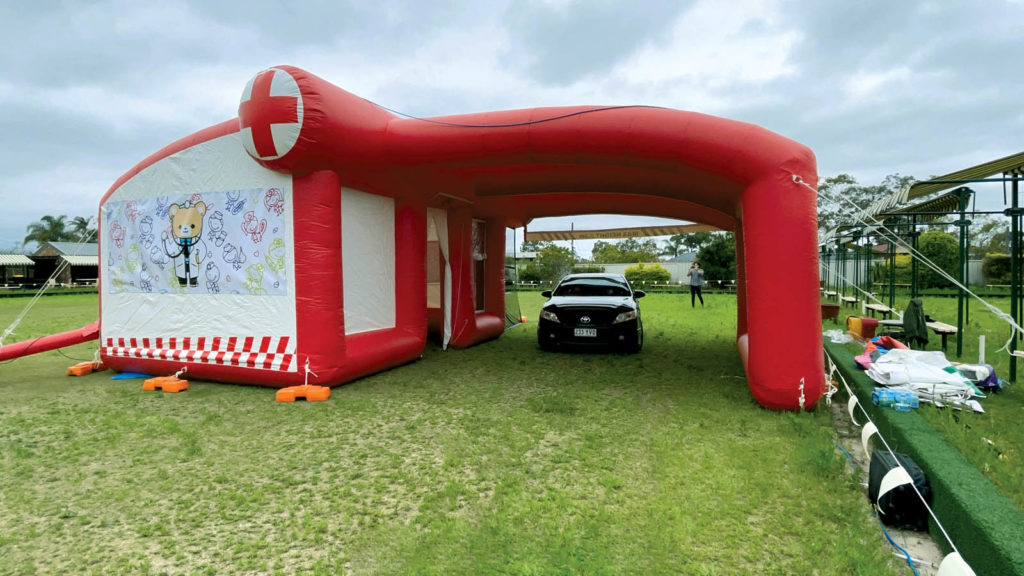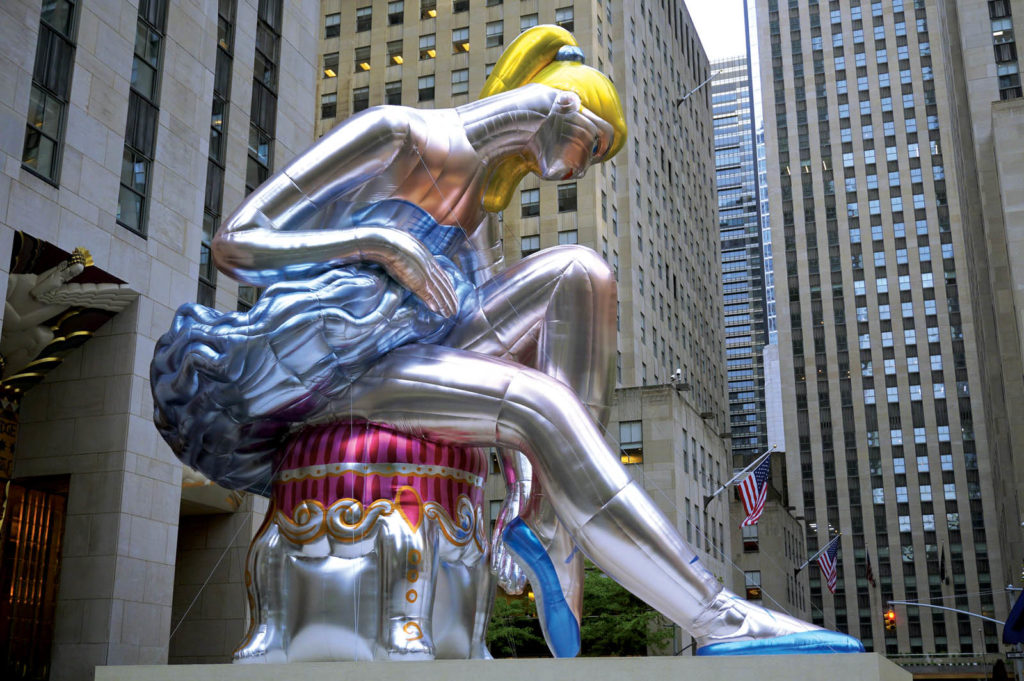
The year has been a good one so far for David Abramowitch, Inflatable Engineer and CEO of Giant Inflatables, in Melbourne, Australia.
“We’ve got two divisions: a sports marketing division and an industrial division. The sports marketing side is giving us a lot of work right now with projects for World Cup Cricket, Rugby and Soccer. And we have many products we’re preparing for the 2022 FIBA Women’s Basketball World Cup, which will take place in Sydney this fall.”
And if that wasn’t enough, the company has been recognized by Guinness World Records for having the largest dancing stickman and the largest disco ball.
But the company also has a serious side. After being under pandemic lockdown for 262 days, Australians have become more safety conscious and are starting to see the value of inflatable buildings.
“Although they’ve been used by the army for years, COVID has made inflatable buildings much more acceptable and safer,” Abramowitch says. “The Chinese made huge inroads into getting inflatable hospitals and laboratories up everywhere during the first wave of the pandemic. Unfortunately, in Australia, we didn’t. The problem in Australia was that the government had very specific ideas about testing. Rather than bring the testing to where people lived with inflatable testing stations, they made the people go to testing centers.”
But if that was a missed opportunity, small inflatable buildings are being called into service to help maintain a waning profession. “One of the latest projects we did was with a guy who is a sheep shearer. In Australia, sheep shearers are a dying breed, but the sheep still need to be shorn,” Abramowitch says. “This gentleman started a business where he can bring his shearing building, with all his equipment and tools, directly to the farm and inflate it.”
Versatility
Growth in the industrial side of Giant Inflatables stems from getting people to understand the versatility of inflatables, Abramowitch says. For example, because inflatables conform to whatever contains them, they make ideal instant plugs. Wherever pipes, ducts, vents or tunnels need to be temporarily sealed to stop air or water flow or control contamination, inflatable blocking bags are a fast solution.
For salvage operations, the company’s inflatable lifting and buoyancy bags replace heavy equipment with products that are light and efficient.
“You put a bag under anything—a block of concrete, a car or truck, or even a plane—and you can lift it with very little pressure,” Abramowitch says. “We are doing a lot more inflatable lifting bags and blocking bags than we have ever done before.”

A long way from tennis domes
“Our bread and butter used to be sports, but the market has changed,” says Donato Fraioli, head of Technical Sales and Product Development at ASATI (Air Structures American Technologies, Inc.), based in Rye Brook, New York.
“We used to put up a lot of tennis domes—10,000 to 30,000 square feet,” he says. “Now we’re working on structures that are growing to 80,000 or even 200,000 square feet, much more often. We’re building these multimillion-dollar structures.”
These are not just standalone air structures anymore, he says. The structures are often built as part of youth entertainment parks or schools. “I’d say it has almost become a necessity for a school to have an indoor space. Many schools are turning to air-supported structures because kids demand indoor recreation spaces where they can play intramural sports and so on.”
Fraioli says there’s no faster, more cost-effective way to build such spaces than with an air structure. “Schools and other facilities can really stretch their budget,” he says. “Instead of a 30,000-square-foot conventional building, they can get a 120,000-square-foot space and serve all kinds of community needs.”
Fraioli says this has taught him that there is a growing need for industrial/commercial structures. ASATI recently patented what it calls a Rapid Deployment Structure. It’s a container package that has everything needed to quickly build an air-supported system. It includes HVAC units, doors, garage doors, and the dome which is rolled up inside. The structure can be deployed anywhere in the world.
The Rapid Deployment Structure recently found a purpose at Cornell University. “I had always wanted to find a way to bring air structures into agriculture because indoor growing is so important,” says Fraioli. “With indoor growing, you can reduce pesticides and you can extend seasons so more produce can be grown locally—think of growing produce in New York in the winter.”
ASATI teamed up with Cornell University to deploy the structures for a research project in hemp farming. They are the same design as the ones used for the military but with a different fabric that lets sufficient light through the roof.
“I believe indoor growing has the potential to be a gigantic market for air-supported structures,” Fraioli says.

Art and entertainment
Technology has always driven market expansion for Landmark Creations, in Burnsville, Minn. When company President Stephanie Meachem started there in the 1990s, the company was making rather simple inflatable products that would be rented to advertise car dealerships or open houses. But Meachem was intrigued.
The shapes were basic and the design sculptures on which they were based were made from clay. The designs were scaled by projecting them on a wall, but that often led to distortions. Around that time Meachem discovered Adobe Illustrator. The program featured vector graphics that allowed designs to be scaled to any size without distortion.
This new capability enabled the company to design and build inflatables with far more complex shapes and of all sizes. Moreover, the designs can be flattened out so the pieces can be printed. “When it comes to our fabrics, if they are not a solid color, they are digitally printed now,” Meachem says. “We no longer paint on the fabric as we did in the past.”
Landmark Creations often works with the event and entertainment industries, making inflatables for set decoration and more. “For the last 10 years or so there has been a push in the entertainment industry that the inflatables also have to be performant, that they have to do something,” she says.
Whether that something is having an inflatable appear out of thin air, having video projected on it, or spraying confetti or smoke, producers want something that will make a splash. Sometimes the performers integrate with the structure itself, like when The Black Eyed Peas performed inside a Landmark Creations snow globe on the Oprah Winfrey show.
When structures are built for such events using the right fabric is key, Meachem says. “People love the metallic look, but we have to consider if the event will be televised, will the metallic finish reflect lights and cameras? Do they want a metallic look that is toned down a bit?”
One of the biggest recent projects, in both size and scope, was building an inflatable replica of the famous Moon Person trophy for the MTV Video Music Awards. “It was ginormous,” Meachem says. “It wasn’t just a display; it was the actual stage.”
Inside the Moon Person’s torso was a tunnel lined with LED panels, through which all the acts and presenters made their way to the stage.
“That was, by far, in terms of the scope, the magnitude, and the complexity of it, the largest project that we have done,” Meachem says. “There are very few inflatable companies in the world that can do what we do at the level that we do it.”
The entertainment industry is a small world, she says, and the company’s reputation is always on display. “You build a reputation and become known as the go-to company for this kind of thing. But there’s also a little risk involved because if you screw up one job, everyone is going to know that too,” she says. “So far, our team has been knocking it out of the park, so I couldn’t be prouder of them.”
Tim Goral is the senior editor of Specialty Fabrics Review.
 TEXTILES.ORG
TEXTILES.ORG


